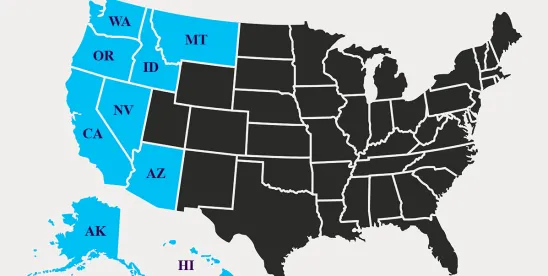Last year, the U.S. Department of Justice filed a lawsuit in the U.S. District Court for the Central District of California challenging the constitutionality of California’s linkage of its cap-and-trade program to a similar program operated by Quebec. As a result of the linkage, entities may trade compliance instruments across jurisdictions, which expands market opportunities for regulated entities and others. On July 17, 2020, the Court ruled in favor of California on all remaining claims, affirming the constitutionality of California’s linkage with Quebec and ending the case, barring appeal by DOJ.
Background
The U.S. DOJ challenged the California-Quebec linkage on four distinct constitutional grounds, alleging that California’s actions to link its cap-and-trade program to Quebec’s program violated the U.S. Constitution’s Treaty Clause, Interstate Compact Clause, the Foreign Affairs Doctrine, and the Foreign Commerce Clause. In an earlier ruling on March 12, 2020, the Court rejected the federal government’s claims that the California-Quebec agreement violates the U.S. Constitution’s Treaty Clause and the Interstate Compact Clause. In its July 17, 2020 decision, the Court granted summary judgment in favor of California on DOJ’s final remaining claim, holding that California’s program does not violate the Foreign Affairs Doctrine. The Court also granted DOJ’s request to voluntarily dismiss its Foreign Commerce Clause claims. This decision, in combination with the Court’s March 12, 2020 decision, puts an end to the federal challenge absent an appeal to the Ninth Circuit.
The Foreign Affairs Doctrine Decision
The July 17 opinion addressed competing summary judgment motions to resolve whether the California-Quebec linkage violated the Foreign Affairs Doctrine. Under the Foreign Affairs Doctrine, state actions may be preempted if they either (1) conflict with or pose an obstacle to a federal treaty, statute, or policy (this is called “conflict preemption”) or (2) if the action falls outside the realm of “traditional state responsibilities” and also intrudes on the power of the Federal government to craft foreign policy (this is called “field preemption”). The District Court rejected federal claims under both prongs of this test.
Conflict Preemption
The United States argued that California’s actions to link its greenhouse gas emissions program to that of Quebec created an obstacle to the implementation of both the Global Climate Protection Act of 1987 (“GCPA”) and the United Nations Framework Convention on Climate Change of 1992 (“UNFCCC”), of which the United States is a party. The United States also argued that California’s program is inconsistent with President Trump’s withdrawal from the Paris Agreement of 2015 (which the Court refers to as the “Paris Accord”), which is currently underway (but which can occur no earlier than November 4, 2020, under the terms of the Paris Agreement).
The Court first found that the GCPA was primarily an “appropriations rider” and that it is made up of mostly “platitudes,” therefore California’s program could not create an obstacle to its implementation. The Court then found that California’s program was “entirely consistent” with the objectives of the UNFCCC and therefore was not in conflict with that treaty.
The United States also attempted to argue that California’s program was inconsistent with the Trump Administration’s intent to withdraw from the Paris Accord because the linkage assisted Canada in fulfilling its commitments under the Paris Accord. The Court initially noted that while the Trump Administration has given notice of its intent to withdraw from the Paris Accord, the earliest that such a withdrawal could take place under the terms of the Accord would be in November 2020, therefore the United States is still a party to the agreement. California and Quebec, as subnational entities, are not themselves parties to the Paris Accord. Furthermore, the Court noted that if the United States does in fact withdraw from the Paris Accord, then Canada would not be permitted to utilize the linkage between California and Quebec’s programs to meet its commitments under the Accord, because such linkages may only be utilized if they are between parties to the Paris Accord. As a result, the Court concluded there is no conflict between the California-Quebec agreement and the Administration’s intent to withdraw from the Paris Accord.
The Court further found that there were no other Federal treaties, statutes, or official policies rejecting the type of cross-border mitigation strategy employed by the California program and that the Trump Administration’s claim that it intends to negotiate a “better deal” on international climate change measures—at some undefined point in the future—was not sufficient to constitute such a policy. Consequently, the Court held that California’s linkage of its cap-and-trade program to Quebec dos not conflict with Federal law or policy and is not preempted.
Field Preemption
The Court likewise rejected federal claims that the California-Quebec agreement intrudes into a field preempted by the federal government. The Court observed that California’s program exceeds the traditional scope of state responsibilities because it explicitly attempts to encourage other countries to take action to reduce greenhouse gas emissions, rather than only seeking to impact emissions taking place within the state. Nonetheless, the Court held that California’s program did not intrude upon the power of the Federal government to engage in foreign affairs, because the program is not in conflict with any existing treaty, statute, or official policy. The Court noted that a future treaty, statute, or policy may preempt California’s program, but held that the United States’ “fears” of such future intrusion are merely speculative.
What’s Next?
The District Court has now disposed of the federal challenge to the California-Quebec agreement. Unless the federal government appeals, the agreement with Quebec will remain one of the cornerstones of California’s efforts to reduce greenhouse gas emissions through a cap-and-trade regime and may serve as the model for linkages to other jurisdictions in the future.





 />i
/>i
